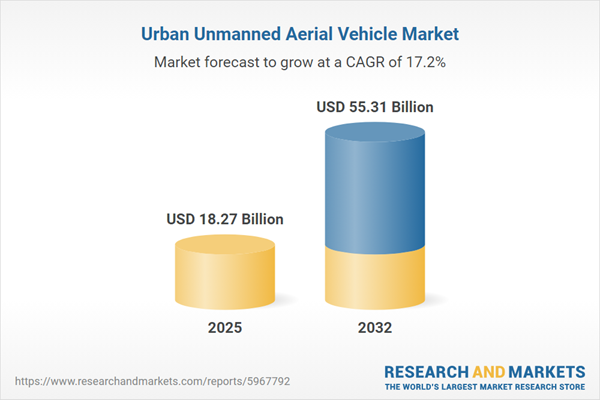Speak directly to the analyst to clarify any post sales queries you may have.
The urban unmanned aerial vehicle market is rapidly advancing, as cities worldwide integrate drone technologies to enhance operational efficiency, safety, and innovative public services. Senior decision-makers now face both new opportunities and challenges as the ecosystem transitions from trial deployments to scalable, citywide solutions.
Market Snapshot: Urban Unmanned Aerial Vehicle Market Overview
The Urban Unmanned Aerial Vehicle Market grew from USD 15.57 billion in 2024 to USD 18.27 billion in 2025. It is expected to continue growing at a CAGR of 17.16%, reaching USD 55.31 billion by 2032. This robust upward trend reflects accelerated adoption across city management, logistics, and infrastructure, driven by rising capabilities and more supportive regulatory frameworks.
Scope & Segmentation
- End Use: Civil infrastructure, disaster management, government and defense, oil and gas, power, transportation and logistics.
- Application: Emergency medical services, land surveying and mapping, surveillance and inspection (including bridge, building, and power line inspection), traffic monitoring, waste management.
- Type: Fixed wing, hybrid, rotary wing models.
- System: Multiple UAV, single UAV deployments.
- Technology: Electro optical and infrared (thermal imaging, visible imaging), lidar (3D and bathymetric), mimo radar, multispectral sensors.
- Payload: Multi sensor, single sensor configurations.
- Regional Coverage: Americas (including North America, Latin America such as United States, Canada, Mexico, Brazil, Argentina, Colombia, Peru, Chile), Europe, Middle East & Africa (United Kingdom, Germany, France, Russia, Italy, Spain, Netherlands, Sweden, Poland, Switzerland, United Arab Emirates, Saudi Arabia, Qatar, Turkey, Israel, South Africa, Nigeria, Egypt, Kenya), Asia-Pacific (China, India, Japan, Australia, South Korea, Indonesia, Thailand, Malaysia, Singapore, Taiwan).
- Company Coverage: SZ DJI Technology Co., Ltd., Parrot SA, Skydio, Inc., Yuneec International Co., Ltd., EHang Holdings Limited, Autel Robotics, Inc., AeroVironment, Inc., Volansi, Inc., Matternet, Inc., Flytrex Aviation Ltd.
Key Takeaways
- Artificial intelligence and advanced sensing are enabling drones to operate safely and autonomously in dense urban environments, supporting faster decision-making and operational reliability.
- Collaborative partnerships among technology vendors, municipal authorities, and service providers are driving the creation of standardized platforms and interoperable solutions suited for large-scale city deployment.
- Municipalities and private operators are expanding UAV use cases, from critical infrastructure inspection to dynamic congestion management and parcel delivery, supporting broader smart city objectives.
- Segmentation by end use and payload type allows organizations to tailor fleets to specific operational challenges, maximizing return on technology investments.
- Regional adoption is influenced by varying regulatory landscapes, with areas such as Asia-Pacific leveraging public investment to accelerate urban UAV integration, while the Americas focus on regulatory clarity for commercial applications.
- Leading and emerging UAV companies are investing in modular architectures and open systems, bolstering platform adaptability and fostering an ecosystem that supports rapid technology upgrades.
Tariff Impact
The introduction of U.S. tariffs on imported UAV components in 2025 has significantly altered global supply chains. OEMs and suppliers have adapted by implementing localized production, nearshoring strategies, and modular design to mitigate cost increases and maintain component availability. These industry adjustments are influencing manufacturing footprints and accelerating regional innovation initiatives across the sector.
Methodology & Data Sources
This report is grounded in comprehensive research, combining secondary sources such as academic, industry, and regulatory publications with primary insights from structured expert interviews and proprietary end-user surveys. Segmentation is validated using advanced analytical models and robust data triangulation, ensuring credible, actionable market intelligence.
Why This Report Matters
- Directs executive strategy with actionable insights on emerging technology trends, regulatory dynamics, and new business models in the urban UAV domain.
- Enables informed prioritization of investments across high-impact market segments, applications, and regions undergoing rapid UAV adoption and infrastructure modernization.
- Reduces uncertainty by highlighting supply chain and policy changes, supporting resilient sourcing and manufacturing decisions tailored to local and global contexts.
Conclusion
The urban unmanned aerial vehicle market is evolving as an indispensable facet of smart city growth and operational resilience. Senior leaders can leverage this report to align strategic initiatives, maximize near-term value, and secure long-term competitive positioning within an expanding ecosystem.
Additional Product Information:
- Purchase of this report includes 1 year online access with quarterly updates.
- This report can be updated on request. Please contact our Customer Experience team using the Ask a Question widget on our website.
Table of Contents
3. Executive Summary
4. Market Overview
7. Cumulative Impact of Artificial Intelligence 2025
Companies Mentioned
The companies profiled in this Urban Unmanned Aerial Vehicle market report include:- SZ DJI Technology Co., Ltd.
- Parrot SA
- Skydio, Inc.
- Yuneec International Co., Ltd.
- EHang Holdings Limited
- Autel Robotics, Inc.
- AeroVironment, Inc.
- Volansi, Inc.
- Matternet, Inc.
- Flytrex Aviation Ltd.
Table Information
| Report Attribute | Details |
|---|---|
| No. of Pages | 199 |
| Published | October 2025 |
| Forecast Period | 2025 - 2032 |
| Estimated Market Value ( USD | $ 18.27 Billion |
| Forecasted Market Value ( USD | $ 55.31 Billion |
| Compound Annual Growth Rate | 17.1% |
| Regions Covered | Global |
| No. of Companies Mentioned | 11 |









